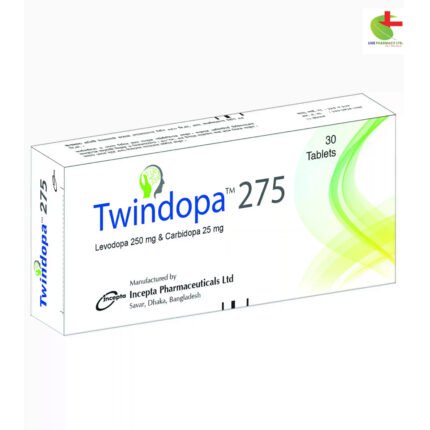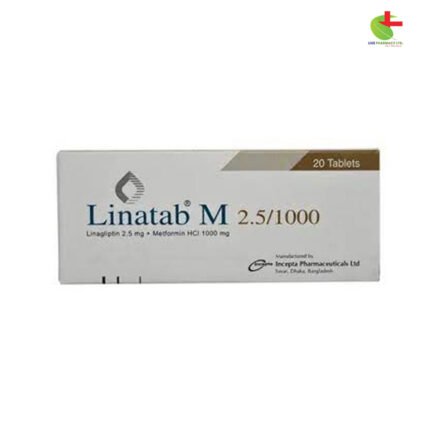Linatab M 2.5/850
140.00৳ Strip
- Linatab M combines Linagliptin and Metformin Hydrochloride to manage blood sugar levels in adults with type 2 diabetes.
- Improves insulin sensitivity, reduces liver glucose production, and boosts insulin secretion.
- Used alongside diet and exercise for optimal glycemic control.
- Always follow a healthcare provider’s guidance for the best results.
 Brand
Brand
|
Incepta Pharmaceuticals Ltd |
|---|---|
 Generics
Generics
|
Linagliptin + Metformin Hydrochloride |
 Type
Type
|
Tablet |
Indications
Linatab M is prescribed as an adjunct to a balanced diet and regular exercise regimen to help manage blood sugar levels in adults with type 2 diabetes. It is specifically recommended when combined treatment with Linagliptin and Metformin Hydrochloride is deemed appropriate.
Note: Always use this medication as directed by a registered healthcare professional.
Pharmacology
- Linagliptin: An effective DPP-4 inhibitor, Linagliptin increases the levels of active incretin hormones (GLP-1 and GIP) in the body. This helps to stimulate insulin release from the pancreas and reduce the production of glucagon, improving glycemic control.
- Metformin Hydrochloride: A widely-used biguanide, Metformin works by decreasing liver glucose production, reducing intestinal glucose absorption, and enhancing insulin sensitivity. It helps manage both basal and post-meal blood glucose levels, without causing hypoglycemia.
Dosage & Administration
- Immediate-Release Tablets:
- Starting Dose: For those new to Metformin, begin with 2.5 mg Linagliptin and 500 mg Metformin Hydrochloride twice daily.
- Maximum Dose: 2.5 mg Linagliptin and 1000 mg Metformin Hydrochloride twice a day with meals. Gradual dose adjustments are recommended to reduce gastrointestinal side effects.
- Extended-Release Tablets:
- Starting Dose: For patients not currently on Metformin, initiate with 5 mg Linagliptin and 1000 mg Metformin Hydrochloride once daily with a meal.
- Maximum Dose: The total daily dose should not exceed 5 mg Linagliptin and 2000 mg Metformin Hydrochloride.
For patients switching from other forms of Linatab M, simply adjust to the equivalent dose of extended-release formulation.
Note: Always consult a healthcare provider for individualized dosing recommendations.
Drug Interactions
- Cationic Drugs: Certain medications (e.g., amiloride, digoxin, morphine) may interact with Metformin, affecting renal elimination.
- Carbonic Anhydrase Inhibitors: Drugs like Topiramate can increase the risk of lactic acidosis when used with Linatab M.
- Inducers of P-glycoprotein and CYP3A4: Rifampin can reduce the effectiveness of Linagliptin. Consider alternatives when co-administering with strong inducers.
- Drugs Affecting Glycemic Control: Some medications may lead to either hyperglycemia or hypoglycemia, requiring closer monitoring of blood sugar levels.
Contraindications
- Renal Impairment: Contraindicated in patients with renal dysfunction due to the risk of Metformin accumulation and lactic acidosis.
- Metabolic Acidosis: Should not be used in patients with acute or chronic metabolic acidosis, including diabetic ketoacidosis.
- Hypersensitivity: Avoid in patients with known allergies to Linagliptin or Metformin Hydrochloride.
Common Side Effects
- Nasopharyngitis (common cold symptoms)
- Diarrhea
- Hypoglycemia (when used with sulfonylureas)
Pregnancy & Lactation
Linatab M should only be used during pregnancy if absolutely necessary. There are no adequate studies on its use during lactation, so caution is advised for breastfeeding mothers.
Precautions & Warnings
- Lactic Acidosis: Symptoms include abdominal discomfort, rapid breathing, and muscle cramps. Immediate medical attention is necessary.
- Pancreatitis: Discontinue Linatab M if pancreatitis is suspected.
- Vitamin B12 Deficiency: Long-term use may lower vitamin B12 levels, requiring annual monitoring.
Alcohol: Excessive alcohol consumption can increase the risk of hypoglycemia and lactic acidosis.
Overdose Effects
In the case of an overdose, immediate medical attention should be sought. While Linagliptin is unlikely to be dialyzed, Metformin Hydrochloride can be removed by hemodialysis.
Therapeutic Class
Combination Oral Hypoglycemic Medications
Storage Instructions
Store Linatab M in a cool, dry place below 30°C, away from light and moisture. Keep out of reach of children.













Reviews
There are no reviews yet.